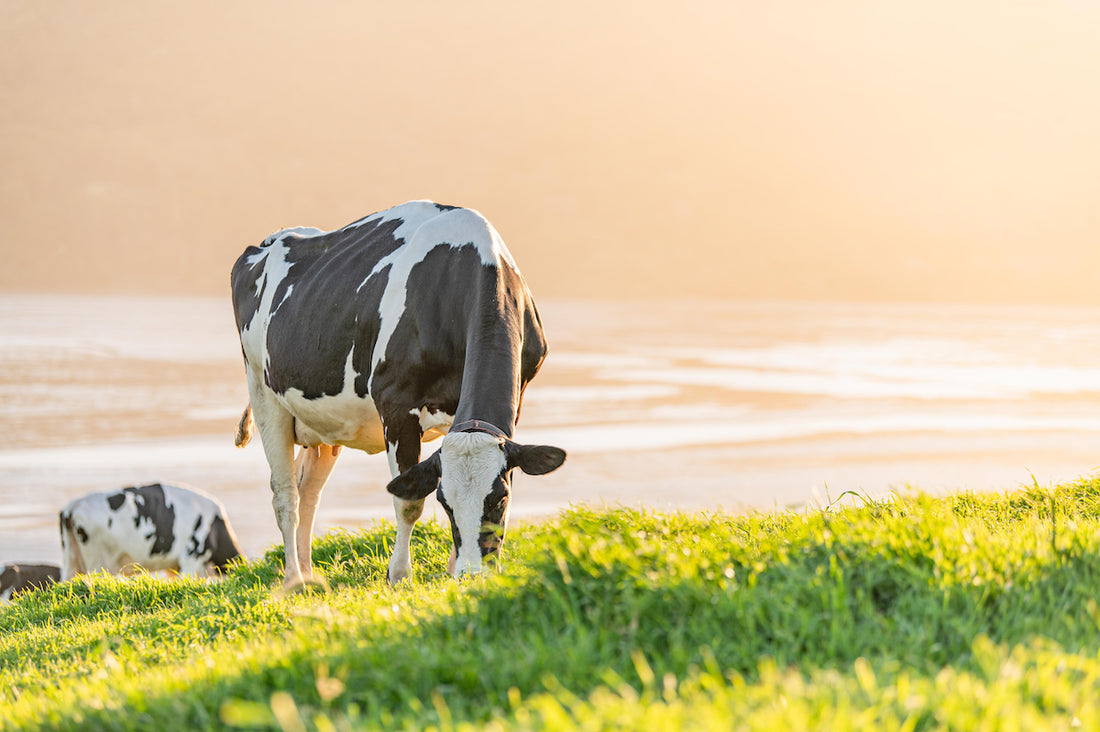We stand by the fact that happy cows come from California, but there’s more to it than great weather, rolling hills, and West Coast vibes. We have long been raising happy cows through sustainable farming practices and this directly correlates to the overall quality of our milk. These benefits can be tasted in every bite of our artisan cheese.
Sustainability on our dairy farm has been at the forefront of our practices since 1959. First and foremost we are stewards of our land in hopes of maintaining it for future generations. Applying innovative sustainability practices within our cheese company creates great benefit to our environment through bettering the land, air, and water. But it makes great business sense too, for we believe the quality of our cheese is absolutely impacted by our farming methods.

Cow Care
Happy cows are healthy cows and healthy cows produce the best milk! That’s why we invest in top quality feed for our cows, which includes all-natural byproducts from other agricultural industries. Utilizing food sources that would otherwise end up in a landfill, mixed with our rye grass, be it fresh from the pasture or as harvested silage, not only contributes to the health and quality of life for our cows, but carries into our sustainability practices.
Our cows graze off the land about six months of the year (depending on weather and rainfall), ensuring not only the health and exercise of the animals, but that the milk they produce tastes like the region from which it is made.
We have a nutrition expert who helps us blend the perfect meal for our herd. Our green pastures of luscious rye grasses are a great natural resource for us, but it’s no coincidence that California is called the Golden State; we go from gorgeous green hills to golden brown in a matter of days once early summer hits. To ensure our cows enjoy the flavor of our land all year long, we make silage every spring, which becomes the primary component of our cows’ diet during the dry months. By harvesting our fields at their peak quality, then storing the cut grass in a way which allows for anaerobic fermentation, we can maintain the nutrients and flavors of the crop throughout the year.
Since cows are ruminants, they can feed on many locally produced byproducts of our own food system. We manage animal nutrition to ensure our sustainable farming methods result in quality milk components, which in turn brings farm fresh taste to our cheese.Canola oil pellets, almond hulls, cotton seed, rolled corn, distillers’ dry grain, and brewers’ malt (from one of our favorite local beer producers, Lagunitas Brewing Company) would all end up as waste (and either burned or dumped in landfills), but instead we are able to upcycle these ingredients to enhance our cows’ diets. These byproducts offer nutritional benefits such as protein, fiber, healthy fat and essential vitamins for our hard-working gals.
In addition, we feed leftover whey from our cheese making to supplement a great deal of protein and flavor. Whey is a byproduct that would otherwise need to be collected and trucked off of the farm to a treatment facility. Whey is not only a nutritional food source for our cows, but it’s also an additional productive source of methane gas when mixed with manure. We use approximately 40% of our excess whey to feed our cows and the remaining 60% is fed into our methane digester. By upcycling the whey ourselves, we are able to minimize extra labor, gas, and emissions, thereby broadening our sustainability practices.
Our “Closed Loop” Process
As dairy farmers, we are well aware of the value of our manure, and happy, healthy cows make the best kind! Not only do we recycle the nutrients of manure by spreading it back on the fields to promote soil fertility, but we also power our farm with it. We call this process a closed loop, where the nutrients are used and reused in a continuous circle.
We use recycled water from our creamery to flush out the waste components from our barns. The solids and liquids are mixed together and then pumped into a separator machine where we take out about 10-12% of the fibrous material. We upcycle the solids into both cow bedding and fertilizer.
The liquid coming off the separator is collected in a covered lagoon which captures the resulting methane gas and runs an 80 kilowatt generator. The renewable energy created supplies our on-farm operational facilities: the milking parlors, barns, creamery and The Fork, our Culinary and Educational Center. On average, our methane digester supplies about 50% of our total energy needs.
We utilize our waste water in a timely application for our annual silage crop production and for generating quality grasses for grazing in the late winter through early summer. During the digestion process bacteria is broken down, leaving us with a pure, almost clean nutrient. This byproduct liquid is in a “plant ready” state, allowing for efficient absorption and timely pasture growth.
Our cheese is an expression of the healthy land where it’s produced. We know the care we put back into our farm is a direct relationship to the flavor profiles in our cheese. Healthy lush rye grasses, indigenous to our coastal geography, contribute to our uniquely delicious milk flavor, creating a full circle from land to cheese.
Balancing Innovation & Tradition
Our farm has been sustaining our family going on four generations and the ways in which we take care of the land ensure that our legacy will live on for future generations. We are more than dairy farmers and artisan cheese makers, we are a family steeped in traditions always looking for ways to better our environment by reducing our carbon footprint. The happiness of our cows is directly impacted by their healthy diets and land stewardship, which is why we place sustainability above all else.


